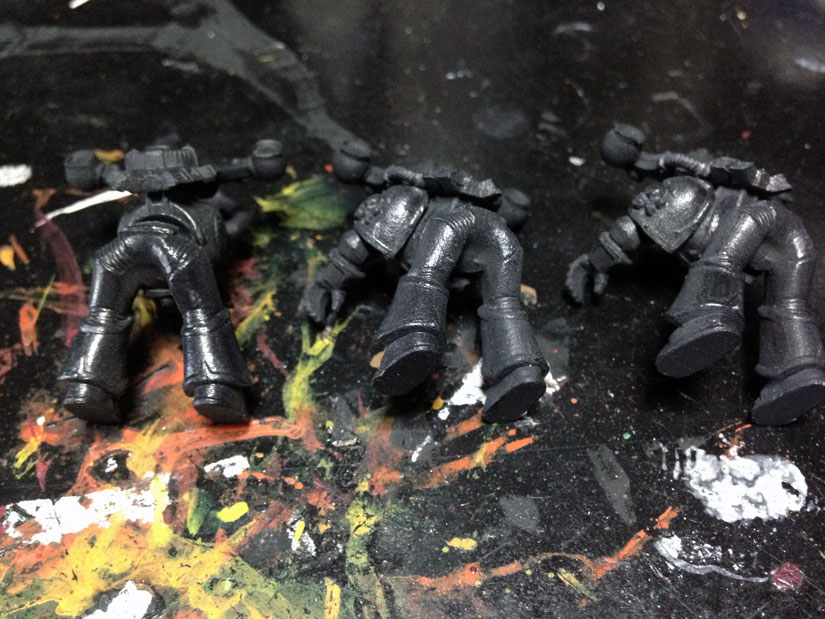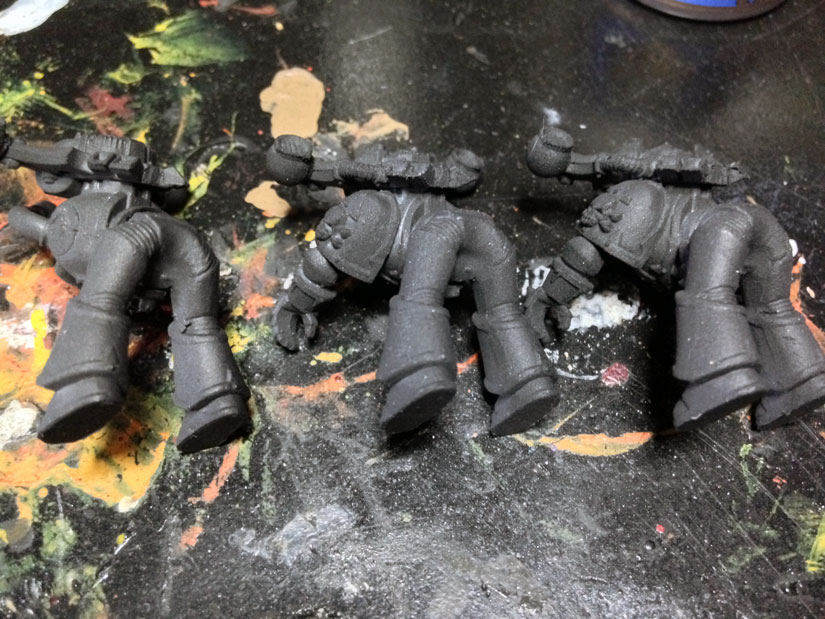Using primer on your miniatures is an essential part of the hobby. It’s something everyone should do prior to painting their models. So, let me walk you through what to buy and how to prime your models.
Disclosure: Some of the links below are affiliate links, meaning, at no additional cost to you, I will earn a commission if you click through and make a purchase. The commission earned helps maintain this site.
Miniature Primer is Essential
It still amazes me how many hobbyists forgo primer and will instead either paint directly on the surface, or will use a matte spray paint as their base coat.
I’m no expert. I can’t tell you the exact science of what makes a primer effective at what it does, but I can tell you that it does make a difference.
The short of it is that it adheres better to your models than normal paint, and it also gives you a better surface to paint on. Primers are created to stick to the surface you’re spraying and to receive paint. It is its job.
By not using a primer you are only hurting yourself. Your paint is less likely to stick to the model, and in turn more likely to come off either through handling, or by dropping the model. This is especially true on metal models. Oh god, if you don’t prime a metal model first then your paint is not staying on there at all. Trust me.
Most of us seal our models. Sealing helps protect all the work you’ve done. Still, even a sealed model can take damage. If you didn’t prime the model then it’s way more likely to chip down to bare metal/plastic than a model that is primed; even if it’s sealed.
See, if that first layer of paint is not adhered well to the model (no primer was used), then the impact of a model falling will cause that first layer of paint to loosen up and chip. However, if you used a primer then the paint is stuck on there well and it’s way less likely to chip off.
Do yourself a favor, prime your models. Not priming models is one of the most common mistakes new painters make.
What Miniature Primer to Buy?
So what primer should you use? I’ll cover that below, but I also wanted to talk about what color to use.
Also note, I’m in the United States. So, access to some of the items mentioned are subject to your location.
Primer Colors
The most forgiving color you can prime your models is black. It can be hard to put light colors on it (white, yellow, orange, etc), but the nice part is if you forget to paint in an area, then it just looks like a shadow.
Using black will also make your colors a bit desaturated (dull).
You will also commonly find grey as a choice as well for a primer. Grey, unsurprisingly, is somewhere between using black and white. It’s an easy color to paint over for darker and lighter colors, making is pretty ideal for most stuff you’re doing.
White primer will give you the most saturation (brightness) on your colors. It’s great if you’re working with a lot of very bright colors. It’s more difficult if you’re using darker colors, but still not the worst thing in the world. Dark colors over white is easier than light colors over black.
Spray Primers
The first one I used that I liked was by Armoury. Armoury went out of business years ago though, but you can still find it at some gaming stores. It’s a bit pricey, but it’s a larger can and it goes on well.
I have used Dupli-Color, which is an automotive primer, and had great success with it. They have a bunch of specialty ones so be careful what you get.

I used their sandable primer, basically their run of the mill one. Don’t get their filler primer or anything like that, bad things will happen. Dupli-Color also has their primers in white, that lovely rust red color, and gray.
My experience with Dupli-Color was that the first half of the can is perfect. It goes on as it should and creates a great surface to be painted. That first half of the can is probably the best primer I’ve used ever.
The second half of the can? Yeah, that’s the problem.
It seems no matter how much I shake the can, how often, the temperatures, and humidity I work at, the second half of the can goes on watery and coverage is terrible. So, a bit of a mixed bag there.
For a good many years I used Krylon’s black primer and had very good luck with it. The problem I had was that it’s on the expensive end of things. However, I never had any issues using Krylon. It sprayed well, adhered well, and didn’t wear off. I’d definitely recommend this one.

The one downside with Krylon now is it’s a paint and primer, which isn’t ideal.
What I’m currently using is Brite Touch. It’s another automotive primer and also by Dupli-color, but a different version. This one works great. The Brite Touch I’ve been using for a few years now.

Like I said, I liked Krylon but it was getting too expensive. When I couldn’t justify the cost for a can for Krylon, I started looking at primers again. I found this one at an automotive store for less, tried it, and haven’t looked back since.
How to Prime a Miniature
Time needed: 1 minute
You’ve got your miniature, you’ve got primer, so it’s time to get to it!
- Attach the Miniature to Something
A little tip is to attach your models to a stick or piece of wood. You can do this using Blu Tack easily.
By attaching the model to something like a stick, you can turn the model as you’re spraying to make sure you cover it from every angle. It’s hard to do that when the miniatures are standing on a box or something.
You can also buy a Citadel Colour Spray Stick. This is a very handy tool that lets you attach multiple models to the stick with bands. There’s a handle so you can easily tilt the miniatures at different angles to get full coverage. - Shake the Can
Shake the living hell out of the can. You want to spend around 30 seconds shaking the can before you use it.
- Spray from 10-12″ Away
One of the biggest issues people run into with a spray primer is by spraying too far away from the miniature. If you’re too far back spraying then what happens is the spray starts to dry in the air before it hits the model. The dried spray hits the model and leaves a fuzzy coating on there.
I do have a trick for dealing with that though.
Fuzziness from the spray drying before hitting the model.
So, you want to remain around 12″ to 10″ from the miniature when you’re spraying. If you’re too close then it will pool up on the model, and too far will cause the drying/fuzzy issue. - Swing the Can Back and Forth
When you’re spraying, start the spray beside the model so the spray doesn’t hit the miniature. Drag the spray over the miniature and stop spraying when the spray is no longer on the model, like how you started. Just one swipe like this.
Doing this will avoid the primer building up where you start and where you end with the spray.
Dave from Wargaming Tradecraft has a great little video showing what I’m talking about.
How to Fix Fuzzy Primer Issues
It happens to everyone eventually. Whether you’re new to the hobby, or a veteran, fuzzy primer happens. In my case, I was priming from too far away. When you do that, the primer begins drying before it hits the model, and in turn leaves a fuzzy coat. I know better, but we all mess up.
Thankfully for me, the fuzzy areas are not in very obvious spots, the underside of the models. I tried to get a shot of it, but it’s really hard to show fuzzy primer on such a small scale, especially since it was minor in the grand scheme of things.
In this situation where the fuzziness is minor, and it’s not in a very obvious spot, I have a trick I like to use to fix it. You don’t need to strip the models either.
Step #1
Get yourself an old toothbrush.

Step #2
Take the toothbrush and scrub the areas that have fuzzy primer. The process effectively buffs the area, and in turn smooths it out.
Now, it’s not going to completely remove it, and make it perfect, but it will make a noticeable difference. How well it works will depend on just how built up the fuzziness is.

You can see the shiny spots now from where the toothbrush buffed the primer. If you wanted, you could go ahead and use a brush on primer, or spray prime, in these areas to remove the glossy sheen to give you better adhesion for your base coat. However, I don’t typically bother. I find even buffed as it is, the primer still takes the base coat well enough, and I’ve never had any issues as a result.
That’s it. A really simple way to deal with fuzzy primer without having to strip your models.
Airbrush Primers
I admit that I don’t airbrush, so my suggestions are based on the experience of other hobbyists.
Now, I have done some airbrush priming in the past though. A fellow author here, Kamui, showed me how it’s done. I admit, it was fun to do, quick, no toxic smells, and worked well. This would be my preferred method for priming if I had an airbrush.
I’ve heard great things by fellow hobbyists about a primer from Badger. Zab mentioned it below in comments, and Shaun on Facebook also suggested it.
Thanks for the tip, guys!
Also, and you’ll see this one below in the brush-on primers too, is the Vallejo primer. It’s a brush-on primer, but of course you can use it in an airbrush as well, which is what Cylde does.

Brush-on Primers
There’s a few options available for brush-on primers, but I only have experience with one of them.
My general opinion of brush-on primers is that I don’t like them. I don’t find they give you the same surface to work with that a spray primer does or an airbrush primer. It just feels less like a primer and more like black paint.
However, that could just be my experience with my limited use of them.
There is a Citadel one called Imperial Primer. It may be no longer in production though. Anyway, I use this from time to time to do spot priming, like if I missed a spot spraying, or I have to repair damage.
To that end it works pretty well. However, for covering an entire miniature I would not recommend it. I find it separates too much. You have to shake the hell out of the pot, and stir it around, just to get something halfway decent for coverage.
Often you’ll be doing two coats as well, which I’m not a fan of. It’s useful to have on hand, but I do not recommend doing full models with this.
Another option, not one I’ve used by one another author here has, is Gesso. It’s an acrylic primer used by canvas painters, but I know Kamui (author here) has used it with great success.
I do know it’s super affordable, and a nice feature is you can add a drop of paint to the Gesso to create a colored primer.
Another option, which I know virtually nothing about, is from Vallejo. The only reason I’m mentioning it is to give another option, and I’m a big fan of Vallejo products in general.
Anyway, it’s a brush-on primer at a great cost, so it’s worth checking out.
The Best Miniature Primers
Here’s my top 3 picks for primers of those I’ve covered above.
Accounts
Free Trial
Projects
SSL
Gesso
$
Brush-on
Requires Mixing
Cheapest Option
Brush-on Primer
Easy Cleanup
Badger
$$
Airbrush
Use As-is
Very Affordable
Airbrush Primer
Easy Cleanup
Brite Touch
$
Spray
Use As-is
Very Affordable
Spray Primer
No Cleanup
Conclusion
At the end of the day, there’s a lot of worthwhile primers you can find at varying prices. The point is to make sure you’re using one. Seriously.
The primer you choose is up to you as well. Try some different colors and see what you think. Try the spray, airbrush, and brush-on if you like. They all have their use and one of them will suit your needs.
If there’s one piece of painting advice I can give anyone it’s to use a primer. The second piece would be to seal your models after. If you do those two things then you’re going to have models that will last you forever.
If you’re a new hobbyist, and are looking for other supplies you need, then definitely check out our article on essential miniature painting supplies.
What do you use for primer?
Hobby Supplies, Tips & Tutorials
Various tutorials and guides for common hobby supplies.
- Creative Twilight’s Future and My Thoughts (Feedback Welcomed!) - December 4, 2021
- My Top Gift Ideas for Miniature Painters & Hobbyists + Gifts to Avoid - December 2, 2021
- The Year That Was 2020 and Where I’ve Been - January 17, 2021







Ha that is a great tip. Mine old solution was to throw the model and primer angrily, and storm out of the room.
Been there, and that’s how I stumbled on to doing this. I was pissed off, had it on my desk, and trying to find some way to salvage it without starting over.
That’s pretty much what I do so I’m going to try this the next time it happens.
Let me know if it works out. It should.
I tried it on some miniatures that has been collecting dust since I primed them, probably 2 years ago. It didn’t get all if it off but I didn’t expect it too but it got most of it off.
You’ll definitely get varying degrees of success with it depending on how badly the priming was. Still, glad it had some positive results.
Yeah I have done this before, but mine was spraying when it was too cold, and this caused a similar effect. I ended up using very fine sandpaper to fix the issue (luckily it was on a DE raider heich has alot of flat areas which caught alot of the fuzziness). I will have to try the buffing trick next time this happens to me
It works really well on flat surfaces, which of course is where you notice it more. It won’t be perfect, but it goes a long way to addressing the problem. I just hate stripping models when I don’t have to.
Humidity can also cause issues with this. If it’s mild, I find that using an ink/shade for my base coat can sometimes smooth it out. Did that with some second-hand Daemonettes that had been badly primed, and most of them turned out alright.
I’ll have to try a wash for the base coat, on top of what I did, and see how it goes.
Great tip Thor! I’ve done this so many times! The worst part is the fuzz also ruins the details in the model. I will give this tip a go for sure.
Thanks! Like I said, I know better too, but I guess I was just not paying attention that day. I didn’t notice till I picked them up to paint them and realized my mistake. Gave me the chance to do this article though ;)
Yeah, losing detail is the worst. It’s not as bad on flat surfaces, the fuzziness, but obscured details sucks.
Truly, it is a mighty weapon that you wield! Good tip, too!
A toothbrush is scary to some ;)
Thanks for the tip. Been there before. Now I need to buy a toothbrush….
If only toothbrushes were easier to find…
A single can of Krylon lasts for a lot of models around here, so that’s what I use.
I used to use a mix of black craft paint and glass/tile medium, but that was more trouble than it was worth, especially on vehicles.
Any sort of brush-on primer I see as being used as a last resort.
I do like Krylon, but I’m saving around $2 a can with Brite Touch and still getting great results. There was a time when I was priming a lot of models and that $6 a can was adding up quick. Still a great choice regardless though.
Krylon’s Fusion and Camo lines also function as primer. I really like them, and I know a couple of pro painters who swear by them. Amazon says they’re like $7, but I’m pretty sure I’m not paying more than 5 at my local Ace. Haven’t bought one in a while because I generally don’t prime in winter, so not completely sure on that, tho.
I think the fusion line is taking over their normal line of primers. Pretty positive I’ve used it and it worked great if I’m remembering the right stuff…
The only issue I have with the Fusion line is making sure I grab the matte instead of the satin. It’s an easy mistake to make, and I’ve seen things labeled “gloss” that were less shiny than that satin.
Oh, and I have a buddy who hand-primes everything with Imperial Primer. Works for him apparently, but everyone else thinks he’s nuts. I do really like it for times when I’m doing something like breaking off an arm/weapon and replacing just that one bit, tho.
Whatever works. I’m like you though, I’ll use it for small stuff only.
Badger is the best brush on/ airbrush primer i have ever used. Worth it’s weight in gold and unlike vallejo it is sandalbe if you weren’t through with your prep.
I’ll check that out!
ooooh it comes in all the colors toooooooo! lol :P
Great post. I usually use Vallejo Primer. Normally a grey one, but don’t mind using browns or bone if required.
The brush-on one that I mentioned or a different one they have?
Yes, but i airbrush it.
One thing I’d recommend when priming with spray paint is to stand the can in hot water for 10 minutes. The paint flows much better when it’s been warmed up and I’ve found it eliminates any problems when spraying in cold weather.
I’ve never had to do that, but it makes sense if you’re stuck doing it in colder than ideal temps. Good tip!
It mixes easier in the can and you don’t need to dislocate your shoulder shaking it up as much ;-) . Sometimes it can take several shakes before the can starts to rattle. If it has been in hot water for 10 minutes it rattles immediately and the paint viscosity is much improved. It goes on so much smoother that I always warm the can up now, even when the weather is warm outside.
Hey, now! I was once a young man and got the proper “can shaking” exercise down to a science. No shoulder dislocation required ;)
I always warm the can up, too, but I usually just keep it under my armpit for the duration of an episode of something on Netflix or Hulu. I’ll have to try the hot water, see if the extra heat makes a difference in the cold weather.
People don’t prime their models still? Damn!
Always found brush off primer rubs off on your fingers, so I only use it as a patch up like you do
Amazingly, yes, some people still do not prime their stuff. Literally 10 minutes ago I was checking out a site and someone was saying they just brush on white craft paint; no primer – white craft paint. It makes me cringe every time I see stuff like that.
One of the things that I’ve found has made the biggest difference to my success in priming is attaching the Models to some sort of stick or rod with tape or blu-tac or whatever rather than putting them on an upturned box. It makes it way easier to get all angles while still keeping the spraycan upright the whole time. Haven’t had issues priming even in somewhat sketchy weather since I started doing that.
Good call. I started doing that a few months ago and I agree, it just makes life easier. I’ll add that in here.